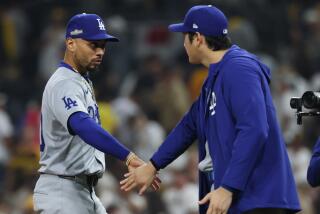Baseball’s Future Curveballs
- Share via
Baseball’s television problems have reached epidemic proportions at a time when the sport is in more need of money than at any time.
With the CBS and ESPN contracts expiring after next season, baseball may have a very different look come 1994. Some of the possible changes will be discussed during this week’s Winter Meetings in Louisville, Ky., as the sport’s executives seek ways to make baseball more attractive to television and cut what is expected to be a huge drop in the fees networks pay to carry the games.
Some, including ESPN anaylst Peter Gammons, favor a realignment of baseball’s league and playoff structure.
“We’re definitely going to the three-divisional set-up,” Gammons said. Such a plan would mean three teams and a wild card, a la the NFL, would reach the playoffs, with the opening playoff round going to a cable network. “My guess is that it will start in the 1994 season with the new TV contract. In turn, they’ll have to shorten the schedule to 150 games, which is no loss whatsoever.”
“From there, if you go to three divisions, you’ll eventually have to go 5-5-5. ... They’ll have to expand by one team in each league by say 1996. If you go to three five-team divisions, then you’re going to have to have some form of inter-league play.”
After the year 2000, Gammons said, he expects baseball to realign itself along geographical lines, mixing current American and National League teams in the same division.
Gammons said he believes a three-division alignment, which would double the playoff spots, would create more interest and the additional round of playoffs would have fans following the playoffs earlier.
But Dodger Manager Tommy Lasorda backs the status quo.
“I like it the way it is now,” said Lasorda. “You don’t water down the playoffs. If you had more teams that could qualify for the playoffs, that would create more interest, but you don’t want to get like other sports where everybody makes the playoffs.”
To one of Gammons’ ESPN colleagues, a three-divisional setup would be an abomination.
“It would render it down to the level of the NBA or NHL, where the regular season becomes almost meaningless,” said Keith Olbermann, the former KCBS and KTLA sportscaster who joined the all-sports cable network earlier this year.
“The vagaries of a short, pressure-packed series may render the work of a whole season null and void. You could walk into an extra round of playoffs with the best record in baseball, and get smoked. I don’t think that’s appropriate.”
When the American and National Leagues each grew to 12 teams in 1969, the leagues divided themselves into two six-team divisions and created league championship series to determine the World Series participants.
“The World Series right now because of the best-of-seven format in the playoffs and other things baseball has done wrong, has been reduced to the level of the NBA championship,” Olbermann said.
“It used to be an epic event and baseball has done almost everything it could to reduce its stature. The World Series was the foremost sporting event in the world. If you put in an extra tier of playoffs, all it’s going to be is the last round.”
Although the added round of playoffs is being considered in large measure to make baseball more attractive to television, the heads of the sports divisions of all three major broadcast networks called the plan a mistake during a late Oct. 29 taping of Bob Costas’ nationally syndicated radio program.
Baseball was under fire this season for many reasons. One of the biggest complaints was over the lengths of the games.
Olbermann said an improvement would be to enforce a rule that has long been on the books but never called--charging a ball against a pitcher not throwing a pitch 20 seconds after receiving the ball when the bases are unoccupied. Olbermann would also call a strike against a batter who steps out of the batter’s box more than once during an at-bat.
Another problem baseball encountered in 1992 was the departure of younger fans. In an ESPN survey of 10- to 14-year-olds, only 6% of the respondents selected baseball as their favorite sport and only 4% tabbed a baseball player as their favorite athlete.
To lure back younger fans, Olbermann advocates playing some World Series games during the day. Although the World Series was exclusively a daytime affair until 1971, there hasn’t been a day game in the World Series since Game Six of the 1987 series, when a Minnesota-St. Louis Cardinals game had a 20.9 rating on ABC.
That was a 45% decrease from Game 6 of the previous year (which also benefited from having teams representing two of the nation’s largest markets--the New York Mets and Boston Red Sox.)
“I fell in love with baseball when we sat around in school and watched the World Series on TV,” Olbermann said. “I can remember sneaking a radio into class for the 1969 World Series.
“It may have been my first sportscasting job. I got to give updates on the scoring, raising my hand and saying, ‘Bottom of the third, Baltimore leading, 1-0.’ It was a communal event for us.”
But with this year’s World Series ending at 12:52 a.m. on the East Coast, such a feeling is lost, Olbermann said.
“Kids do not see the games,” Olbermann said. “There couldn’t have been a dozen kids in the East watching the end of this World Series. That’s terrible.”
More to Read
Go beyond the scoreboard
Get the latest on L.A.'s teams in the daily Sports Report newsletter.
You may occasionally receive promotional content from the Los Angeles Times.










